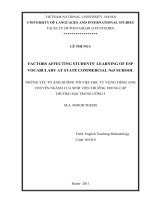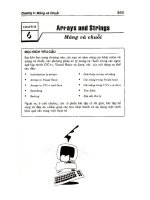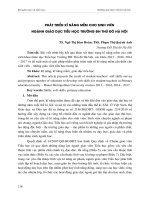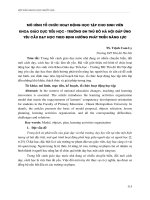giao duc tieu hoc cd dh tieng anh chuyen nganh
Bạn đang xem bản rút gọn của tài liệu. Xem và tải ngay bản đầy đủ của tài liệu tại đây (107.58 KB, 7 trang )
English word
There are many trees around us. They have different shapes and sizes.
Which parts of the tree are included?
Each plant has parts: root, stem, leaves, flower, fruit and seed
From a green bean plant, how to make more bean plans?
From a green bean plant, to produce a lot of bean plants, wait for the bean to
produce the flower to fruit, until the fruit ripens. Then, the seeds is inside the fruit
and sowed and it will give more bean plant. In addition to reproduction as the bean
plant, there is another form of reproduction. It is reproduction by the steam, with
branch or also called asexual reproduction. For example: vegetable stalks,
sugarcane stalks, cut branches, ...
A. ASEXUAL REPRODUCTION
I. Vegetative organ and define
The seedlings grow from which part of the mother plant? To understand better we
complete the following table:
No
Tree name
Produce of the seedings
Grow from which
What type of
Under what
part of the tree?
organ is that?
conditions?
1
Cucumber
Steam
Vegetative organ
Moist soil
2
Ginger
Steam
Vegetative organ
Moist soil
3
Potatoes
Root
Vegetative organ
Moist soil
4
Burn Tree
Leaf
Vegetative organ
Moist soil
Thus, seedlings can grow from the stem, roots, or leaves from the mother
plant itself, without the need to combine with other plants. It is asexual
reproduction. The form in which the seedlings can grow from a part of the mother
plant.
And parts of the plant: the stem, the root, the leaf are called the vegetative
organ of the plant
General characteristics of the vegetative reproduction: the formation of new
plants from the vegetative organ of plants in condition of moist soil.
II. Characteristics of asexual reproduction in plants:
So, we realize characteristics of asexual reproduction in plants:
• The new tree is the same as the mother tree
• Adaptive life is a place where there is moisture
III. Application of asexual reproduction in plants
There are 3 forms :
1. Branches: make the branch to creat root on the new trees and then cut it to plant
other tree.
2. Cuttings: cut a segment of branch with enough eyes, shoots and then plant it in
condition of moisture soil to the branch that make root and develop into a new tree.
3. Mutual eyes: bring the vegetative part of the plant is the eye. The shoot of this
plant are attached to other plants (rootstock) for the plant to continue to grow.
B. SEXUAL REPRODUCTION
Fertilization in reproduction is called sexual reproduction
There are two types:
- Reproduction in flowering plants
- Seedlings grow from seeds
I. Reproductuon in flowering phants
1. Reproductive organs:
+ Flowers are the reproductive organs of the flowering plants. Male genital organ
is called stamen. Female genital organ is called the stigma.
+ Some plants have male flowers or female flowers. In most other plants, the same
flower has both stamen and stigma.
2. Reproduction:
a. Pollination
It is the phenomenon that the head stigma receive pollen of the stamen.
There are 2 forms:
+ Self-pollinating : the pollen falls into the head of the flower itself.
+ Cross-pollination : the pollen of this flower moves to the head stigma of another
flower in the same tree or between different plants
Flowers is pollinated by wind or insects:
+ Characteristics of flowers is pollinated by insects: They are often colorful or
fragrant with attractive insects (Eg: phoenix, grapefruit, oranges, lemons, melons,
squash, gourds ...)
+ Characteristics of flowers is pollinated by wind: no beautiful colors, no petals or
their petals are very small ( Eg: maize, rice, ...)
b. Fertilization
+ After pollinating, the pollen grows the pollen tube
+ The pollen tube stabs through stigma and then growing to the ovule.
+ At ovule, male genital cells together with female genital cells to form zygote.
That phenomenon is called fertilization
c. Seed and fruit
+ After fertilization, the zygote develops into embryo
+ The ovule inclues embryo that develops into seeds
+ The ovary include seeds that develop into fruits
Reproductive stages: the pollen fertilizes with the ovule to form zygote embryo
seeds seeds sprout seedlings mature plant with flowers pollen
seeds
II. Seedlings grow from seeds
In addition, there are many trees growing from seeds (green beans, black beans, ...)
but you know why the seeds grow into trees?
1. The structure of the seed:
Each seed include: shells, embryos and nutrients
+ Beyond the shell
+ The second part is the nutrient of the seed
+ The small white opaque part at the top of the middle when we split it in two is
the embryo
2. The conditions for seeds to germinate:
It has the appropriate humidity and temperature (not too hot or too cold)
3. The development of seedlings:
VD: The development of the bean tree from sowing to maturation
+ The seeds are prepared to sow
+ After a few days, the roots grow much. Two leaves sprout, the buds sprout from
the ground
+ Two leaves haven’t fallen yet, the tree sprouts and grows new leaves
+ The tree grows flowers and produce fruits
+ Cut the old fruit to take seeds
+ Take more seeds and we can plant it
III. Advantages of sexual reproduction:
+ Increasing the adaptability of the offspring to ever-changing habitats
+ Creating genetic diversity, create many different individuals with parents
COMPARISON 2 REPRODUCTIVE FORMS IN PLANTS
Definition
Asexual reproduction
The reproductive form without the
combination of male and female
gametes
The new
tree
It is formed from one part of the
tree.
New Breed
Identify the mother plant
Adapt to
living
environmen
t
Weak
NEW WORD
- reproduction (n) : sự sinh sản, quá trình sinh sản
- root (n) rễ
- steam (n) thân
- branch (n) cành
- leaf (n) lá
- flower (n) hoa
- fruit (n) quả
Sexual reproduction
The reproductive form is a
combination of male gametes
and female gametes.
It is formed by the
combination of father and
mother.
Identidy both the mother plant
and the father plant
Good
- seed (n) hạt
- shoot (n) chồi
- seedling (n) sự tạo mầm, cây con (cây giống)
- asexual reproduction (n) sinh sản vơ tính
- vegetation organ (n) cơ quan sinh dưỡng
- vegetation reproduction (n) sinh sản sinh dưỡng
- moist soil (n) đất ấm
- sexual reproduction (n) sinh sản hữu tính
- fertilization (n) sự thụ tinh
- reproduction organ (n) cơ quan sinh sản
- male genital organ (n) cơ quan sinh dục đực
- female genital organ (n) cơ quan sinh dục cái
- stamen (n) nhị hoa
- stigma (n) nhụy hoa
- pollination (un) sự thụ phấn
- to pollinate : thụ phấn
- pollen (n) hạt phấn
- pollen tube (n) ống phấn
- to stab : đâm
- ovule (n) noãn
- male genital cell (n) tế bào sinh dục đực
- female genital cell (n) tế bào sinh dục cái
- zygote (n) hợp tử
- embryo (n) phôi
- ovary (n) bầu nhụy, buồng trứng
- to germinate : nảy mầm
- shell (n) vỏ (the hard outer part of eggs, nuts, some seeds and some animals)
- nutrient (n) chất dinh dưỡng (a substance that is needed to keep a living thing
alive and to help it to grow)
- humidity (un) độ ẩm (the amount of water in the air)
- to sow : gieo hạt (to plant or spread seeds in or on the ground)
- to sprout : nảy mầm, đâm chồi ((of plants or seeds) to produce new leaves
or buds; to start to grow)
- bud (n) chồi, nụ to be in bud: đang ra nụ, đang ra lộc (cây hoa)
- to be edible (a) : không thể ăn (fit or suitable to be eaten; not poisonous)
- gut (n) ruột (ở động vật)









